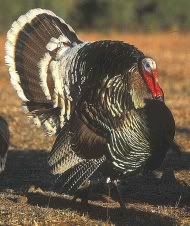 Physical Description
Physical DescriptionGould’s Turkey is the largest of the five North American subspecies. It also has longer legs, larger feet, and larger center tail feathers than other wild turkey. White tips on the tail feathers and tail coverts, which usually separate to exhibit an “eyelash” appearance, distinguish Gould’s from other turkeys. The body plumage is blue-green in color and the lower back and rump feathers have copper and greenish-golden reflections unlike the faintly iridescent velvety black of the Merriam’s. Hens have a less pronounced metallic green and red sheen and are more purplish in color.
Average Weight Range
Mature Gould’s wild turkeys weigh eight to over 25 pounds.
Reproduction
Gobbling activity for the Gould’s occurs from April to June in association with plant growth in its habitat. The increase of daylight hours in also spring triggers hormonal changes. Males exhibit both gobbling and strutting to attract females. Gobbling attracts the hen to the male, who then courts the female by strutting. If the gobbler is successful, the female will crouch to signal the male to begin copulation. The first peak time for gobbling occurs at the beginning of breeding season when gobblers are searching for hens. The second peak begins a few weeks later, when most hens begin incubation. Gobblers usually mate with several hens, and it is generally the adult males who do most of the mating. Hens lay anywhere from 8 to 12 eggs per clutch, averaging about 28 days for incubation.
Food Usage/Selection
Wild turkeys are omnivores, eating a variety of plant and animal matter wherever and whenever available. Poults, or young turkey, eat large quantities of insects and other animal matter to get needed protein for development. As turkeys age, plant matter becomes the primary food source with 90 percent of the mature turkey’s diet including the green foliage of grasses, vines, forbs, acorns, buds, seeds and various fruits.
Range
Gould’s can be found in small numbers in Arizona and New Mexico but is abundant in northwestern regions of Mexico. They inhabit mountainous terrain found in the Sierra Madre Occidental Mountains of Mexico, the Animas and San Luis Mountains of New Mexico and in the Peloncillo Mountains of New Mexico and Arizona.
Habitat
Gould’s utilize areas of underbrush, along creek beds or other areas of thick brush with scattered openings in mountainous regions.
Common Hunting Methods
The shotgun, bow and arrow, and black powder are all used to hunt turkey. To attract turkeys, hunters use a wide range of turkey calls to lure the turkey or to induce gobblers to a fight. Calling has become so popular that contests are held each year so experts and novices alike can fine-tune their skills.
Hunting Challenges/Values
With their excellent eyesight and well-developed sense of hearing, the turkey can sometimes outsmart decoys used by hunters as they become more and more sensitized to their presence. Wild turkeys are very good to eat and can be smoked, fried or baked. Many hunters proudly display their colorful capes, beards or full-bodied mounts.
Interesting Tidbits
Turkeys will answer thunder from an approaching storm with calls of their own.
Turkey hunting is one of the most popular forms of hunting.
Hens produce droppings in shapes like a mound, and the gobbler’s droppings are in a straight line or resemble the letter “J.”
They are the least known of the turkey subspecies, first described by J. Gould during his travels in Mexico.
Read about other Turkey subspecies:
Eastern Wild Turkey
Gould's Turkey
Merriam's Turkey
Ocellated Turkey
Osceola/Florida Turkey
Rio Grande Turkey

No comments:
Post a Comment